Monday, November 14, 2016
Philly and Tekka rolls フィラデルフィア巻き、鉄火巻き
Saturday, July 25, 2020
Horse mackerel wrapped in perilla leaves 鯵の大葉バター焼き
4 raw jack mackerel or "aji" filets (thawed if frozen)
1 tbs miso
1 scallion, finely chopped
1/2 ginger, finely chopped
1/4 tsp soy sauce (optional)
1/4 tsp sugar
10 perilla leaves, washed and dried with stem end removed
Butter for frying
Directions
I first made "namerou" by chopping and pounding the aji with a sharp knife until the aji became a bit pastey. I mixed in the scallion, ginger, miso and sugar and kept pounding until well mixed. You could add a bit of soy sauce to adjust the seasoning and consistency. I placed a small amount of namerou on a perilla leave and folded it into half-moon shape (below)
Wednesday, August 3, 2022
Ikura from Vital Choice バイタルチョイスからのイクラ
I am always looking out for alternative sources of sashimi items such as "ikura" salmon roe. Depending on the source, the quality and price vary a lot. Our Japanese grocery store almost always has it but the per ounce price is very high. Other sources often have Ikura but the roe are a smaller size with a smaller diameter. We like salmon roe with a 5 mm diameter rather than the smaller ones. Sometimes the roe are identified as trout roe, but often the type is not specified so it is very difficult to know exactly what type of salmon roe we are getting. We learned "keta" or "chum" salmon roe fits our preferences best. Recently we have gotten frozen keta salmon roe from Vital Choice. It came as a package of three, 7 oz. glass jars. The price was about average, and the quality was quite good. The 7 oz jar size was also a good size for us because we could generally finish it in 5 days. We have prolonged the shelf life of ikura by adding a marinade. (I use a mixture of x4 concentrated 'mentsuyu" Japanese noodle sauce and sake). Since we used up three of the jars, I went back to order the same but the only choice at that time was a 2 lb. (almost 1 kg) tray. I thought that would be way too much for us to use up before it went bad unless we could somehow divide up the quantity into smaller portions. But the offer was too good to pass up so I took a chance and ordered it. Turned out the pack could be subdivided (see discussion below).
Ikura can be used many different ways. The below is an appetizer of home-made blini, cream cheese, smoked salmon, ikura and chopped chives.
Saturday, May 22, 2010
Sushi Taro, Dupont Circle, Washington DC 寿司太郎
This time we started off with home-made umeshu 梅酒 aperitif with green plum simmered in syrup or "kanroni" 青梅の甘露煮, a very nice refreshing start, which was followed by their signature appetizer Gomadofu 胡麻豆腐 topped with Maine sea urchin, real wasabi (every time wasabi was served, our chef grated a wasabi daikon root with a traditional sharkskin grater--the difference between this wasabi and the usual fake one from the tube was remarkable). Since it was in season, the next was Junsai ジュンサイ in sweet vinegar and yuzu 柚子. Junsai was very fresh with thick gelatinous layers. It matched perfectly with gentle sweet vinegar sauce highlighted with a bright yuzu flavor. (Masa showed us the fresh yuzu they had just received--the very small green kind). We then moved to a simmered dish; Hiryouzu 飛龍頭 and shrimp shinjou 海老しんじょう in yuba 湯葉 sauce. This was a nice comforting dish and well-prepared, if not spectacular. Next came a huge and fresh Pacific oyster (cut into three pieces) from Washington State, Japanese call it Iwagaki oyster 岩牡蛎, on the half shell with a lemon wedge and okinawan salt. This was so good (you may have noticed we are partial to raw oysters). It went so well with the sake we were drinking; a nice fresh ocean taste and, without any special sauce or seasoning, it lingered pleasantly in the mouth for a while. Again seasonality is important here. "Ayu" 鮎 is in season. Japanese, especially Kyotoites, are very fond of this small fresh water river fish and we had this fish quite a few times in Kyoto. The Ayu which had been marinated very delicately in soy sauce and sake 祐庵地 was served butterflied and grilled 鮎の開き祐庵焼き. I like this rendition much better than the customary "shioyaki"塩焼き or salt grilled, which is usually served on a bed of salt and pine needles. Somewhere between these dishes, we had assorted "Hassun" appetizers 八寸 with 8 small tasty morsels; kinome-miso dengaku 木の芽味噌田楽, "aburana" with yuzu-miso アブラナの柚子味噌和え, lightly marinated firefly squid 蛍イカの沖漬け, "tamago-dofu" 卵豆腐, a small savory egg custard square with edamame paste, salt-cured shirako 白子 with vinegard daikon strips, garlic sprouts 芽ニンニク with miso-marinated Manila clams. All were fantastic. The only slight disappointment being the dengaku due to the quality of the tofu which could have been better. The salt cured "Shirako" or cod sperm sac (which does not sound appetizing) was delicate and tasty.
Friday, December 9, 2011
Open sandwich of tuna sashimi and porched egg 鮪の漬けと温泉卵のオープンサンド
Wednesday, January 13, 2021
New year's eve sashimi 2020 年越しの刺身
For New Year's eve, we started with this sashimi. I ordered Atlantic tuna toro 鮪とろ, octopus leg 蛸, and ikura イクラ (all frozen) from Catalina offshore products at least a month ahead of time because last year I waited too long and when I got around to ordering sashimi for New Year they were sold out. I also got sashimi-grade salmon but it was a large piece and would have been too much so I did not thaw it. The toro piece was small (5oz) but enough for two of us. It contained "ootro" 大トロ and small portion of "chutoro" 中トロ. The octopus legs appeared to have been imported from Japan.
Monday, December 28, 2009
Tuna tartar with cucumber and grape 鮪のタルタル
If tuna sashimi is in good quality, it is best to eat it simply with wasabi and soy sauce. If you like to have tuna sashimi in different ways or the quality of tuna sashimi is not really good (often in my case), you could make something different. I already posted a few variations on this theme.
This particular night, I made tuna tartar, which is a fairly common Western adaptation of tuna sashimi. Again, this is not a recipe per se, you could make many variations on this theme to your liking. I just chop tuna sashimi in small cubes, mix in finely chopped chives, soy say sauce with wasabi dissolved, a dash of good quality olive oil to your taste. If you like, you could use, chopped perilla and/or scallion, tabasco, sesame oil etc for variations.
To make the taste a bit more interesting, I made a sweet vinegar miso sauce with Japanese mustard "karashi sumiso" からし酢みそ in addition. I used "saikyo" miso 西京味噌, which is sweet to begin with. I used 1 tbs of saikyo miso, 1/3 tsp of prepared hot Japanese mustard (in a tube), 1/2 tsp sugar, and added rice vinegar until a nice smooth saucy consistency is reached. I did this in a Japanese mortar "suribachi" すり鉢 and pestle すりこぎ but you could use a small bowl attachment using a food processor or you could just buy a premade "sumiso" sauce. Taste and adjust the degree of sweetness by adding more sugar.
Thursday, February 14, 2013
How to prepare small "Toro" block 鮪のトロのさばき方
I have mentioned that it is getting more and more difficult to get fresh blue fin tuna from Catalina Offshore Products because it is offered only infrequently. For that matter, our Tako Grill appears to be having difficulty getting toro as well. The other day, when I checked the Catalina site, both top loin and toro block were available and, without hesitation, I ordered both blocks (small blocks 1lb each).
Here is the first sashimi I prepared on the Friday evening the tuna arrived.

The Toro was just excellent. I served mostly toro and a small portion of chutoro 中トロ (or more like kotoro 小トロ). Since I had half a (leftover) ripe avocado, I also served slices of avocado in sashimi-style. For garnish, I made the usual daikon garnish mixed with mini-cucumber (skin portion only) and carrot. Instead of the usual raw preparation, I salted the vegetables and then squeezed out the excess moisture. I then dressed them with sushi vinegar. The wasabi was freshly thawed "real" wasabi. We have not tasted this kind of good quality toro, actually more like Ootoro 大トロ, for quite some time. This is melt-in-your mouth good. My wife ooed and aahhed appropriately.

I realized that, although I have posted sashimi from Catalina several times and how to prepare the large belly loin block, I did not illustrated how I prepared the small block of tuna belly into sashimi. Since I am running out of dishes I can post, I thought this would be a good punt.

Here is a small one pound block of toro. This is from a rather small tuna and it has the skin on. The left side is toward the belly .

The toro block usually has a very dark red portion called "chiai" 血合い and small top loin portion, in this case, "chutoro" 中トロ. I first removed the chiai part and then the triangular shaped "chutoro" block .

Now I have three portions; on the left toro with the skin still on, chiai in the middle, and chutoro on the right. Usually I discard "chiai" but this time I made a dish from it.

Using a thin sharp blade (since I do not own a traditional "yanagi" knife 柳刃, I used a salmon fillet knife from Global which works fine for me. I removed the skin, by placing the toro skin down on the cutting board then moving the blade horizontally between the skin and toro while pressing on the toro with my palm. I removed a thin layer of mostly fat that was attached to the skin (right above and below picture). I did not discard this almost pure fat.

The left on the picture above is the toro bock. I cleaned up the white membrane ("peritoneal" lining which lines the abdominal cavity of the fish) which is shown on the right edge of the toro block in the picture above. Sometimes bone may be present, so I carefully look for it and remove it. This is a rather small block but I cut it into two making two small rectangular blocks or "saku" from which I sliced the sashimi seen in the first picture.
The portions we did not eat immediately, I wrapped in parchment paper and placed it in a ziploc bag and stored them in the meat drawer of the refrigerator. It should last at least 2 more days.
Monday, September 3, 2018
Otoshi three kinds including octopus sashimi タコ刺身、酢味噌和えとおとうし三種
I served octopus two ways; one was sliced thinly with a wave pattern, which is called "sazanami-giri" 漣切り meaning "ripple cut". My version is more like "big wave cut". This is done so that when dipping in wasabi and the afore-mentioned sashimi soy sauce, the surface will hold the sauce. The other is a tip portion cut into small chunks and dressed in "karashi sumiso" 芥子酢味噌.
The dressing is a mixture of miso, sugar and and rice vinegar in 2:1:1 ratio and added prepared Japanese hot mustard to taste. Recently, I have reduced the vinegar (as per my wife's request) and added a small amount of hot water (from our "instant" hot water dispenser using RO filtered water). This makes the dressing milder and also dissolves the sugar better. I also added small chunks ("rangiri" 乱切り) of American mini cucumber.
Shown below is store-bought fish cake which we like. I grilled it in the toaster oven and dressed with ginger soy sauce (mixture of grated ginger and soy sauce). Since I had chives, I also added chopped chives.
This is another store bought drinking snack made of steamed squid with a "Chinese" style dressing called "Ika-chuka-sansai" イカ中華山菜. Depending on the brand, the taste and ingredients vary a little but this is not bad at all (except some of the large chunks of squid was too chewy for my wife and she graciously transferred them to me).
This is the only one I really made. Cucumber suno-mono with small dried shirasu (whitebait/dried sardine hatchlings) garnished with ikura しらす入りきゅうりの酢の物. Thinly sliced cucumber (American mini-cucumber), salted with moisture wrung out, mixed with "shirasu" (frozen in a package), dressed in sweet vinegar and garnished with ikura.
For a change, we started the evening with tokubetsu junmai "Suigei" 特別純米酒 酔鯨 sake from Kochi in Shikoku 高知、四国. This is a dry sake with acidity but not yeasty at all and went well with these snacks.
Tuesday, April 21, 2015
Take-out sushi and sashimi from Kanpai Sushi テイクアウト寿司
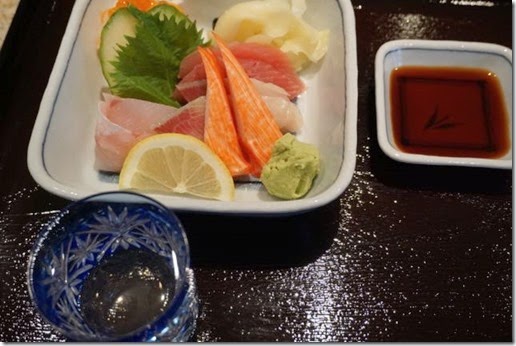
I added daikon namasu 大根なます and ikura いくら salmon roe. The sashimi included flounder, hamachi, tuna, and imitation crab. This was certainly good enough for a Friday evening. The pickled ginger was better than what we buy at the Japanese grocery store.
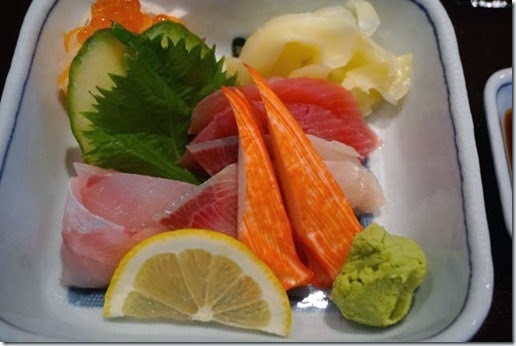
After few more dishes, we had the assorted sushi and rolls as an ending dish. The sushi items included tuna "tekka" roll 鉄火巻き, inari 稲荷. The nigiri are flounder, tuna and tamago. It also included a small sea weed salad which I enhanced by adding yuzu shoyu sauce.
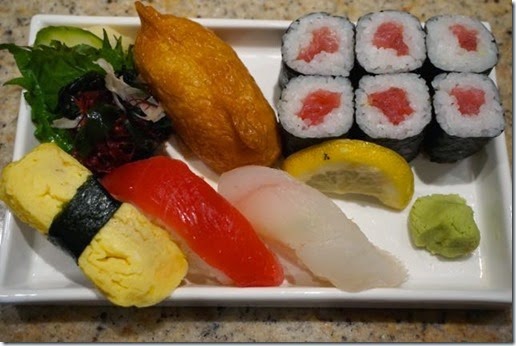
Certainly this is much better than take-out sushi you will find at the grocery stores even from the ones known for "gourmet" food. Compared to other sources of sashimi such as Catalina, with this take-out, we can have the amount we want with more variety and it is also so convenient.
Monday, June 3, 2019
Poke, sort of, and Champagne マグロとサーモンのポケもどき
For the tuna, I used soy sauce, wasabi and perilla as dressing.
For the salmon, I used soy sauce, red pepper paste (from a tube) and dill.
For the sous vide chicken tenderloin, I used soy sauce and yuzu-kosho 柚胡椒 (from a tube) and garnished with sesame seeds.
These three starters borrowed from the concept of "poke" which is getting popular here. Some fast food "poke" chains have even opened up. Instead of our usual cold sake, we started with champagne.
This was among the ones we happened to have on hand. I am not sure when and where I got this one but it is called Philippe Fourrier Cuvée Millésime Brut Champagne 2008. We made an ice bucket to keep the champagne cold. My wife somehow dug up a special cloth/towel we had tucked away somewhere with a representative champagne bottle depicted on it, to absorb the condensation from the champagne ice bucket.
This was vintaged (2008) and had a nice slightly yeasty/beady aroma with subtle melon and green apple taste with fine bubbles and went quite well with this appetizer I prepared.
After this, we had a filet mignon steak, green asparagus and some kind of potato. We switched to 2006 "the Maiden". This was one of the old wines we had stored in our basement. The conditions there, however, are is not really great for the enhancement of wine over time. We were afraid that the wine may have been way past its prime. I carefully decanted it and let it breathe for one hour before serving. There was a definitive brown hue indicating age/oxidization. As it had more contact with air, this wine opened up and we could taste good black fruit, vanilla and chocolate. The tannin was quite mellow. We would have preferred to taste this wine a bit earlier but it did age quite well and went well with our impromptu celebratory steak dinner.
Monday, December 14, 2020
Sushi Taro "regular" kaiseki box "普通”の寿司太郎会席弁当
Wednesday, April 15, 2015
Hanami 1st day with take out sashimi 花見1日目、テイクアウト刺身
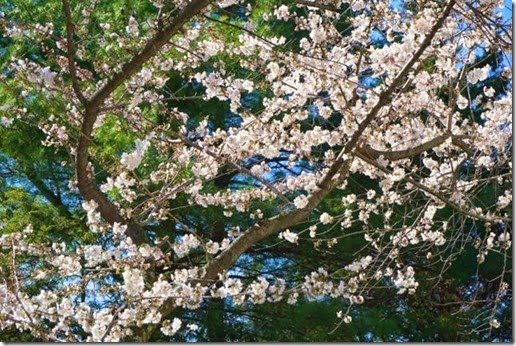
Like Christmas, cherry blossoms come only once a year and we look forward and enjoy "Hanami" 花見 every year.

The first day of hanami, we started our evening with a glass of Cabernet but quickly switched to cold sake. This time, we opened "Dassai 50". This junmai daiginjo is from Yamaguchi prefecture and the flavor profile is similar to our house sake "Mu" 無.
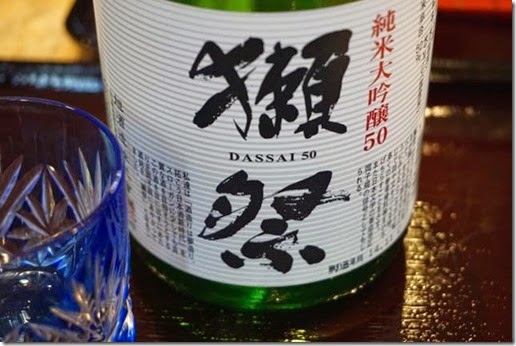
To start with sake, we had garlic chive and egg drop soup, which was followed by this assorted sashimi. We got this sashimi take-out from Kanpai sushi. I divided one order into two servings and added Japanese cucumber with moromi miso or "morokyu" もろきゅう, daikon namasu 大根なますwith salmon roe.
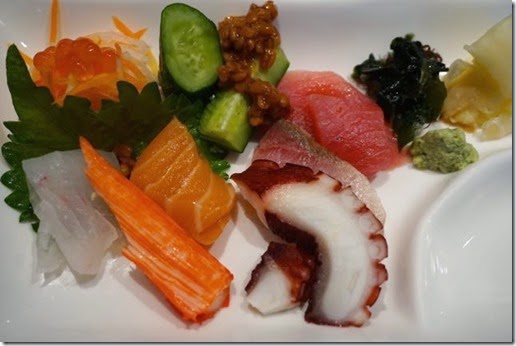
The sashimi included flounder, salmon, hamachi, tuna, octopus and imitation crab. This time I also served "real" wasabi which was just thawed. It also contained mixed seaweed salad (next to the pickled ginger).









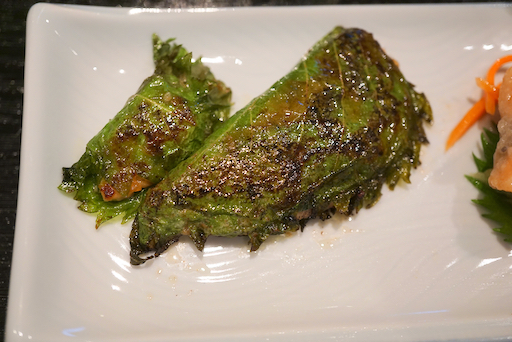
.jpeg)
.jpeg)





















